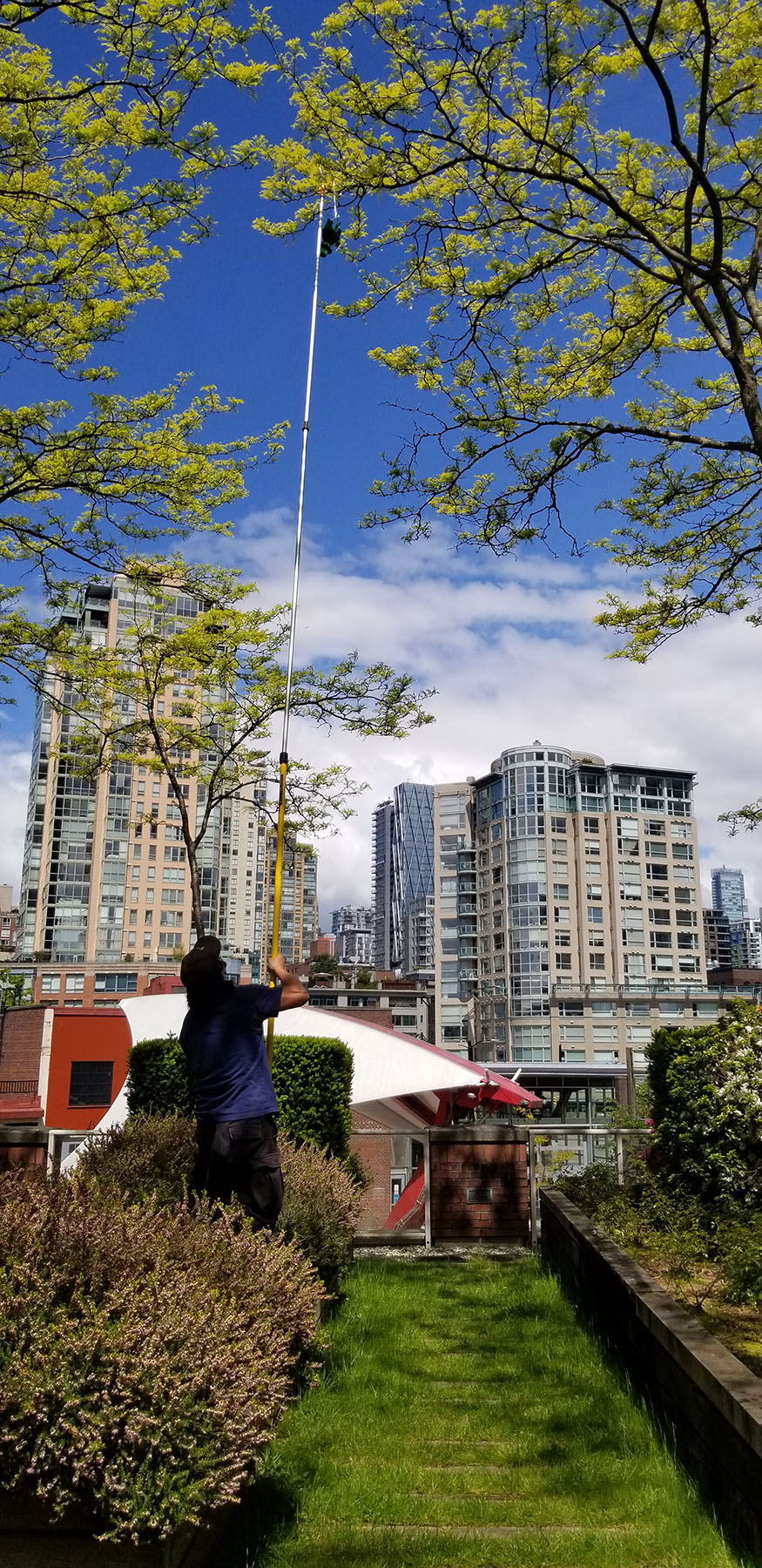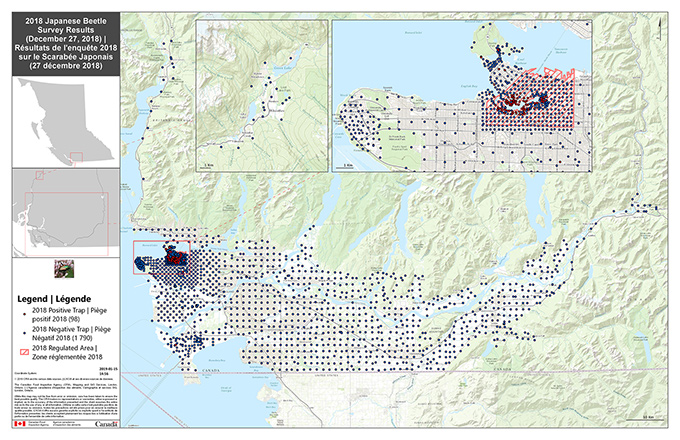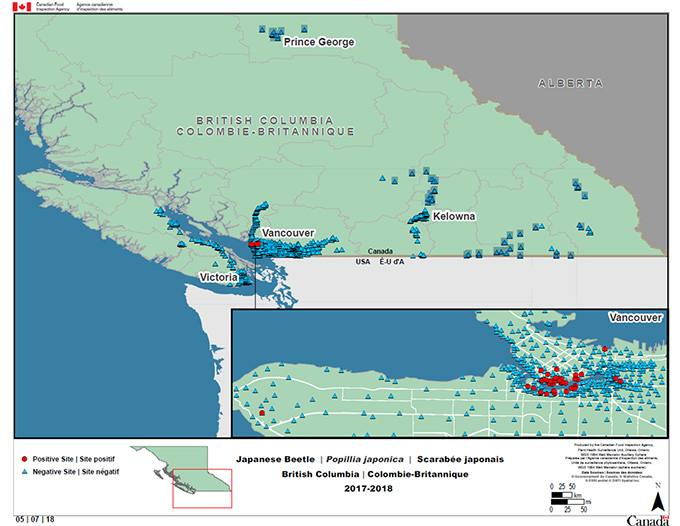2021 | 2020 | 2019 | 2018
Japanese beetle survey methodology | Japanese beetle detection history
| Year | Total Number of Japanese beetle Traps Placed | Surveillance Result (Total Number of Japanese beetle Detections) |
Location(s) of Japanese beetle Detections (Total Number within the Municipality) |
|---|---|---|---|
| 2022 | 5928 detection and delimitation traps | 201 in 68 traps | Burnaby (35) Port Coquitlam (126) Richmond (1) Vancouver (39) |
| 2021 | 2790 detection and delimitation traps | 79 in 45 traps | Burnaby (5) Port Coquitlam (1) Vancouver (73) |
| 2020 | 2507 detection and delimitation traps | 214 in 39 traps | Port Coquitlam (1) Vancouver (213) |
| 2019 | 2344 detection and delimitation traps | 1157 in 51 traps | Vancouver (1157) |
| 2018 | 2088 detection and delimitation traps | 8276 in 98 traps | Delta (1) Vancouver (8275) |
| 2017 | 1425 detection and delimitation traps | 958 in 42 traps | Vancouver (958) |
| 2016 | 505 detection traps | No detections | No detections |
| 2015 | 442 detection traps | No detections | No detections |
| 2014 | 367 detection traps | No detections | No detections |
| 2013 | 278 detection traps | No detections | No detections |
| 2012 | 331 detection traps | No detections | No detections |
| 2011 | 282 detection traps | No detections | No detections |
| 2010 | 545 detection traps | No detections | No detections |
Japanese beetle survey methodology

The Japanese beetle (JB) survey is a trapping program designed to detect incursions of adult JB in BC. The survey is conducted using a JB trap (see Figure 1) consisting of a yellow or green coloured vane which holds a floral and pheromone lure as well as a small container to capture beetles. Traps are placed based on a systematic grid throughout the urban areas of the Lower Mainland, Fraser Valley and at potential high risk introduction locations such as airports, railyards, and green waste disposal sites. Traps are also placed on Vancouver Island and the in BC interior. Traps are placed starting in mid-May, serviced every 3 weeks, and taken down in late-October. The Canadian Food Inspection Agency (CFIA) JB survey provides critical information to the Province of BC and the City of Vancouver who are overseeing treatments on public and private lands where JB has been detected.
2021 Japanese beetle survey results in BC

In 2021, a total of 2,790 JB traps were placed in populated areas in southern BC with 2,524 traps set in Metro Vancouver, the Fraser Valley, Sunshine Coast and Sea to Sky Highway corridor. In total, 2,253 regular ground-based traps, 239 canopy traps (that is traps in trees; see Figure 2) and 16 rooftop traps (rooftop gardens) were placed. One hundred traps were also set on Vancouver Island and 103 traps were placed in the BC interior. Trap placement began on May 5 and was completed by June 22. Trap collection commenced on October 18 and was completed by November 23. As per previous years, the largest number of traps were set in the City of Vancouver, with the highest trap densities occurring in the False Creek, South Granville and South Cambie areas. Additional surveillance around the Vancouver International Airport (YVR) was carried out by the YVR wildlife team around cargo and runway turfed areas. Most traps were checked every three weeks but those in high risk areas such as False Creek were serviced weekly.
The first and last Japanese beetle detections were on June 29 and October 19, respectively. Since treatment started in 2018, the number of trapped JB has decreased every year. This trend continued in 2021, as only 79 JB were caught; this is a 65% reduction from 2020 (214 JB). Although a significant reduction occurred, this is the first year that the majority of JB (50 JB or 63%) were detected outside the Regulated Area (RA) (see Figure 3). Outside the RA, 32 JB were caught in 14 traps in the Queen Elizabeth Park (QEP) area; other than False Creek, this area has the highest number of JB. In 2021, a single JB was detected outside the RA near the south side of Carnarvon Park, and near the location of a single JB detection in 2019. This suggests that the 2019 detection may not have been a hitchhiker, as was previously thought.
Click on image for larger view

Figure 3. 2021 Japanese beetle survey results in BC.
The map shows the locations of Japanese beetle traps placed in the lower mainland of British Columbia in 2021 extending from Squamish in the north down the Sea-to-Sky Highway through Vancouver south to Delta and east to Chilliwack.
The 2021 Regulated Area for Japanese beetle in the Centre of Vancouver is shaded with a red crosshatch and covers downtown Vancouver, the West End, Stanley Park and False Creek and extends east to Clark Drive, south to 12th Avenue and west to Burrard Street, including Kits Point.
There are 2,479 negative traps shown with blue dots extending the entire area surveyed. Out of the 45 positive traps coloured red, a portion are within the Regulated Area, in and to the east of David Lam Park as well as along Expo Boulevard, near BC Place Stadium. Within Vancouver, but outside the Regulated Area, Japanese beetle was detected in and around Connaught Park, Carnarvon Park, Prince of Wales Park, on 15th Avenue between Oak St and Cambie St, near Kingsway and 11th Avenue, at East 24th Avenue and Glen Dr and in the Queen Elizabeth Park area.
Within Burnaby, positive Japanese beetle traps occurred between Charles Rummel Park and Warner Loat Park. In Port Coquitlam, a positive trap occurred on Routley Ave.

There were also detections outside of Vancouver in 2021: 5 JB were caught in 5 traps near Charles Rummel Park in Burnaby, and 1 JB was caught in Port Coquitlam, about 3 km southwest of a single detection near the Riverwood neighborhood in 2020.
Between 2018 and 2021, the majority of CFIA's JB delimitation surveys took place within the RA, and in areas which are primarily made up of multi-unit strata complexes. With JB detections in the Burnaby, Port Coquitlam and the QEP area of Vancouver, the CFIA's 2022 delimitation survey will now include areas which mainly have single-family, detached homes.
A total of 235 traps went missing and 214 were damaged during the survey, some of these were replaced and some were relocated to prevent additional vandalism. Missing traps continue to be a challenge and an additional cost of surveillance. In 2020, some traps were placed in hardwood tree canopies as part of a pilot project to reduce vandalism. Canopy traps outperformed nearby ground traps by catching more JB. In 2021, canopy traps were used again, primarily in known infested areas, to assist in delineating the local population. Although canopy traps (239 traps) only comprised 9.5% of all set traps, they accounted for 53% of all the JB caught (43 of the 79 JB).
Similar to previous years, traps were set on garden rooftops adjacent or close to David Lam Park, that have grass or host plants. In 2021, 16 traps were placed on rooftops; 1 JB was captured in a standard rooftop trap and 1 JB was caught in a canopy rooftop trap. (see Figure 4). The CFIA plans to continue with enhanced JB surveillance throughout BC in 2022. CFIA will also collaborate with research scientists in Ontario and Quebec to improve trap efficacy and to increase the sensitivity of the traps in relation to the decreasing JB population.
2020 Japanese beetle survey results in BC
In 2020, the Japanese beetle survey trap placement began in early May and was completed on June 12. Trap collection commenced on October 15 and was completed by November 16. Due to pandemic travel restrictions, plans for trapping on the Sea to Sky Highway and the Sunshine Coast were deferred to 2021. A total of 2,507 traps were placed throughout the Province and checked at least 6 times from June to October. There were 100 traps placed on Vancouver Island, 71 traps in the BC interior and 2336 traps in Metro Vancouver and the Fraser Valley.
The highest density of traps was placed in the City of Vancouver. Traps around David Lam Park and high risk spots were checked more frequently. A total of 204 traps went missing and 260 were damaged during the survey, some of these were replaced and some were relocated to prevent additional vandalism. Missing traps continue to be a challenge and an additional cost of surveillance; however, we piloted the placement of JB traps in tree canopies to see if these would be suitable replacements for typical ground based traps. In David Lam Park, we found canopy traps performed significantly better than nearby ground based traps. In total, 72 canopy traps, 2263 regular ground based traps, and only 1 roof top trap were placed due to limited access to private properties in the pandemic. The first and last Japanese beetle detections were on June 29 and September 30, respectively. A total of 214 beetles were caught in 39 traps (see figure 5) and of those, 162 beetles were from canopy traps. This result represents an 82% reduction in captures from last year. The CFIA detected only 2 Japanese beetles in 2 traps outside of the regulated area. 1 male was detected near King Edward Avenue and Columbia Street in Vancouver on August 7 and 1 female in the Riverwood neighbourhood of Port Coquitlam on August 25. This is the first time a female has been caught outside the regulated area.
Additional surveillance around the Vancouver International Airport (YVR) was carried out by the YVR wildlife team around cargo and runway turfed areas; no beetles were found in these traps.
In the center of the regulated area, 99% (211 out of 214) of the total Japanese beetles caught were from traps around False Creek from David Lam Park to the 3 adjacent parks (George Wainborn to the West, Coopers to the East and Charleson to the South). 81% (173 out of 214) were found within David Lam Park alone suggesting the incursion is still very centralized and is less dispersed from previous years. There were no beetles detected around any of the 2018 and 2019 positive traps outside the regulated area.
The CFIA plans to continue with enhanced JB surveillance throughout BC in 2021.
Click on image for larger view

Figure 5. 2020 Japanese beetle survey results in BC
The map shows the Lower Mainland, in British Columbia and trap locations in that area for 2020 are identified using blue circles for the negative sites and red circles for positive sites. The regulated area for Japanese beetle is represented by a zone with a pattern of red diagonals. In 2020, positives sites have been found in the Vancouver area only. The insert map shows the details of the positive locations in Vancouver.
2019 Japanese beetle survey results in BC
The 2019 Japanese beetle survey consisted of a total of 2,344 traps placed throughout the Province. The highest density of traps was placed in the City of Vancouver.
A total of 1157 beetles were caught in 51 traps (see figure 6), an 86% reduction in captures from 2018. The CFIA detected 4 Japanese beetles in 4 traps outside of the regulated area and 2 beetles outside the treatment area but still within the regulated area. There were no beetles detected around the 2018 positive trap in Delta and the 2017 detection at University of British Columbia (UBC).
Click on image for larger view

Figure 6. 2019 Japanese beetle survey results in BC
The map shows the Lower Mainland, in British Columbia and trap locations in that area for 2019 are identified using blue circles for the negative sites and red circles for positive sites. The regulated area for Japanese beetle is represented by a zone with a pattern of red diagonals. In 2019, positives sites have been found in the Vancouver area only. The insert map shows the details of the positive locations in Vancouver.
2018 CFIA Japanese beetle survey in BC
In spring 2018, the British Columbia Ministry of Agriculture and partners decided to attempt an eradication of Japanese beetle in Vancouver and the CFIA supported this effort through enhanced surveillance and implementation of movement restrictions for plants and soil from the regulated area to prevent the spread of Japanese beetle life stages. Additionally the CFIA, City of Vancouver, Invasive Species Council of BC, BC Landscape and Nursery Association, MetroVancouver Regional District and other partners conducted extensive outreach with the public and stakeholders to encourage reporting of suspect beetles and compliance with the movement restrictions.
Traps were placed at the same locations as 2017 positive traps and throughout the Lower Mainland and Fraser Valley at various densities based on distances from 2017 positives. In addition, a delimitation survey was carried out around the singleton positive trap on the University of British Columbia campus. Additional traps were placed around new positives detected outside of the regulated area if there was a high likelihood of adult beetles still flying. In these cases, high numbers of traps were placed around the positive trap strategically in areas of suitable turf sites.
A total of 2,088 traps were placed throughout the Province, 8,276 beetles were captured (See figure 7) and the majority were again found around False Creek. This increase in beetles from 2017 to 2018 was expected because treatments applied by the province and the City of Vancouver in 2018 targeted the next generation of developing larvae. The CFIA detected JB in 12 traps outside the regulated area but still within the city of Vancouver. A single beetle was also found in south Delta.
In early 2019, the JB regulated area was expanded to include downtown Vancouver, the West End, Stanley Park, and part of Kits Point near Vanier Park.
Click on image for larger view

Figure 7. 2018 Japanese beetle positive detection sites
The map shows the Lower Mainland, in British Columbia and trap locations in that area for 2018 are identified using blue circles for the negative sites and red circles for positive sites. The regulated area for Japanese beetle is represented by a zone with a pattern of red diagonals. In 2018, positives sites have been found in the Vancouver area only. One insert map on the top left shows details of trap locations north of the Lower Mainland and one insert map on the top right shows the details of the positive locations in Vancouver.
Japanese beetle detection history in the City of Vancouver and the rest of British Columbia
As a result of detecting Japanese beetle in the False Creek area of Vancouver in 2017, the CFIA carried out enhanced surveillance for Japanese beetle in BC from 2017 to 2020. In 2017, the CFIA placed 1,425 traps (see Figure 8) throughout the province but most traps were placed in the City of Vancouver to delimit the False Creek detections and the single detection on the University of British Columbia campus. The rest of the Lower Mainland and Fraser Valley were monitored at a relatively higher trap density to see if Japanese beetle was present in these areas too. In 2017, a total of 958 Japanese beetle in 42 traps were found with approximately 90% of beetles found in and around David Lam Park adjacent to False Creek (see Table 1).
Click on image for larger view

Figure 8. 2017 Japanese beetle trap distribution and positive detections in Vancouver, BC.
The map shows southern British Columbia, from Prince George to the border with the United States and trap locations for 2017 are identified using blue triangles for the negative sites and red circles for positive sites. In 2017, positives sites have been found in the Vancouver area only. An insert map shows the details of the positive locations in Vancouver.